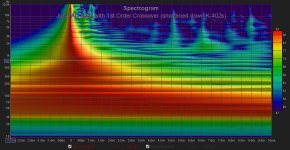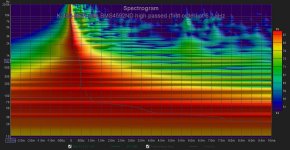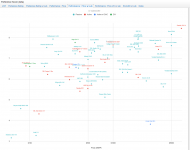I have read their paper. They do seem to have treated the modal behavior well, though it's also clearly lacking proper measurements of the resonances of lower frequencies.Did you guys read the pdf, and saying the JBL room is flawed?
It would be somewhat questionable for someone that they do not control the first reflection, but overall, it is a pretty reasonable room for emulating average consumer listening rooms, imo.
Olive Munich AES Presentation on Harman Reference Room - Google Slides
But the main issue is how they have treated the area above schroeder. Very band limited treatment that functions as a EQ/filter, not placed treatment correctly in order to deal with specular reflections but more spread out that simply makes the room unnecessary more dead/dry, so called diffusers that basically don't diffuse well or function more as focusing the sound in certain directions besides being very band limited.
The fact they show RT60 measurements proves that don't know much of small room acoustics as this type of measurement is completely invalid in such an environment. Well proven and something also Toole understands from what I've read of him.
A challenge is also the fact they have several seats, implying that you need to treat a wider area and which makes the sound more dead compared to treating for one or two listening positions.
I have read their paper. They do seem to have treated the modal behavior well, though it's also clearly lacking proper measurements of the resonances of lower frequencies.
I don't think it's fair to call it “flawed" just because of lacking the measurement, since we don't know how actually it is... We can’t do a lot about low frequency in this size of the room anyway, and proper low frequency treatment should not be their intention because no consumer would do it.
But the main issue is how they have treated the area above schroeder. Very band limited treatment that functions as a EQ/filter, not placed treatment correctly in order to deal with specular reflections but more spread out that simply makes the room unnecessary more dead/dry, so called diffusers that basically don't diffuse well or function more as focusing the sound in certain directions besides being very band limited.
The fact they show RT60 measurements proves that don't know much of small room acoustics as this type of measurement is completely invalid in such an environment. Well proven and something also Toole understands from what I've read of him.
I had a same impression about the treatment on the walls, but their RT60 is showing the room is fine. I wonder why you call RT60 is completely invalid in this fairly large listening room.
A challenge is also the fact they have several seats, implying that you need to treat a wider area and which makes the sound more dead compared to treating for one or two listening positions.
Multiple seating is most probably based on some kind of feedback from the JBL sales team. If they think it is necessary, the room treatment should follow it accordingly...
I never called it "flawed" plasnu. I said it was poorly acoustically treated, which is quite evident for anyone who has knowledge about small room acoustics. Treating a room above the schroeder very band limited is anything but good.
It's well understood that small rooms don't have a proper diffuse field, which is the requirement for RTx measurements and reverberation time. In acoustics this is a small room for sure. For a true reverberation to exist, there needs to be a homogeneous and isotropic sound field. Reverberation is often understood to be equivalent to decay, something it isn't. In scientific literature the term has on the other hand a precise definition.
But this is off-topic and I want comment it further here.
It's well understood that small rooms don't have a proper diffuse field, which is the requirement for RTx measurements and reverberation time. In acoustics this is a small room for sure. For a true reverberation to exist, there needs to be a homogeneous and isotropic sound field. Reverberation is often understood to be equivalent to decay, something it isn't. In scientific literature the term has on the other hand a precise definition.
But this is off-topic and I want comment it further here.
Omholt, sorry, it was not you. I agree with you about the problem with the thin wall treatment we can see here, but practically, that is the treatment the average consumer would do and which they call "standard room". I don't see anything wrong with it. No treatment is better than thin treatment? I don't think so, as long as it is not too much.
Last edited:
No problem plasnu. The issue isn't only that the treatment is band limited but also the placement and type. Having certain frequencies directed to the listener instead of an even distribution is not a good thing. They do have a lot of band limited treatment as well in this room, so it may certainly be worse in some areas than no treatment.
The difference in a room treated like this and a well treated room is huge. How it may have effected their studies is difficult to know. But I find at sad that everything that comes out of these studies seem to be taking as absolutely evidence and science, despite that we have other researches that give different results in some areas.
Accuracy is fairly easy. Preference isn't because there are so many aspects that come into play that will effect the result.
The difference in a room treated like this and a well treated room is huge. How it may have effected their studies is difficult to know. But I find at sad that everything that comes out of these studies seem to be taking as absolutely evidence and science, despite that we have other researches that give different results in some areas.
Accuracy is fairly easy. Preference isn't because there are so many aspects that come into play that will effect the result.
The difference in a room treated like this and a well treated room is huge. How it may have effected their studies is difficult to know. But I find at sad that everything that comes out of these studies seem to be taking as absolutely evidence and science, despite that we have other researches that give different results in some areas.
Accuracy is fairly easy. Preference isn't because there are so many aspects that come into play that will effect the result.
The difficulty they and we are facing is, very few people actually have a well treated room you would approve, probably less than 1% of the people here. JBL / Harman has an access to very well treated room and they should do their own study in those rooms. The meaningful aspect of Dr. Tool's study is he tries to bridge well treated room to the average consumer room, which is far from nonsense, I think. I don't think Dr. Tool has ever claimed his study as an absolutely evidence and science, he is rather just showing the result of his study in fair way. The people who read his article treat it in fundamentalist way, maybe. 🙂
Guys, Floyd Toole retired from Harman in 2007. Sean Olive, Todd Welti and Kevin Voecks have been in major role after Toole. Toole is well known and has written a good book and gives lectures and consulting.
More of Harman's listening rooms at Olive's blog
Audio Musings by Sean Olive: The Harman International Reference Listening Room
Before these standardized rooms around the world they used more heavily damped rooms for evaluations, and mostly just one speaker playing at the time. New rooms are better for multichannel listening and evaluation, and more like normal rooms at home.
More of Harman's listening rooms at Olive's blog
Audio Musings by Sean Olive: The Harman International Reference Listening Room
Before these standardized rooms around the world they used more heavily damped rooms for evaluations, and mostly just one speaker playing at the time. New rooms are better for multichannel listening and evaluation, and more like normal rooms at home.
Last edited:
Thanks for your response.Thanks Chris for a link to your thread about the subconscious effects of low phase growth. A good read!
Even though I don't use horns (or crossovers), it has been my personal quest to find my own opinion on that subject a few years ago. It took quite a bit of work, measurements, room treatment and a dose of DSP to get me there. I've tried to describe its result many times. 🙂
I guess the best testament to its real virtues are the reviews from a few friendly listeners, most of those were from fellow forum members, I've linked to in my first post of what has become a huge thread.
It would help me to know the name of or a link to the thread that you reference. Unfortunately, most of my time and effort is spent on horn-loaded loudspeakers using conventional IIR DSP filtering. I've found that the real problems with phase growth and group delay in the loudspeakers that I use are at lower frequencies below 500 Hz--an area that generally requires more taps in the FIR filters than the DSP crossovers have available to correct.
Generally I use Xilica, ElectroVoice and Yamaha DSP crossovers (mainly Xilica XP series) nowadays. The Xilica "XD" series of crossovers that can do FIR filtering not only cost twice as much as the XP series on average (above $1700 USD at discount prices), but their capacity to correct to linear phase generally ends at 500 Hz, below which you're out of luck.
[I've found that the lower cost DSP crossovers lack the needed fidelity for high performance horn-loaded loudspeakers. This generally includes all the miniDSP crossovers, and other inexpensively priced DSP crossovers. I see a lot of very inexpensive DSP crossovers being used on this forum, but I do wonder if those using them have set up their systems and rooms can hear their sound quality limitations. I hear those limitations quite clearly using the loudspeakers and room treatments that I've described.]
So I've used IIR filters in better sound quality DSP crossovers to achieve essentially the same subjective results as linear phase: loudspeakers with phase and group delay coherence much closer to their calculated minimum phase levels. This approach can't do much for the inherent characteristics of the drivers taken individually, but I've found that removing the crossover-induced phase and group delay distortions has a profound effect on the subconscious/subjective sound quality--just like what Danley is doing. When coupled with the full range horizontal and vertical directivity of higher performance horn-loaded loudspeakers, I found these subconscious effects are very much pronounced.
To date, I haven't heard these same effects with any direct radiating loudspeakers (except perhaps large planars, but they have other issues that I've run into: mainly a tiny "sweet spot" (head-in-a-vice), their room-hogging placements away from walls, the huge amplifier power levels required to produce modest SPL in-room, and their inability to be toed-in in home-sized listening rooms).
I don't know about floor-to-ceiling line arrays, however, as I've not heard a pair of those set up with linear phase FIR filtering and horizontal early reflection control in-room. I'm sure that their vertical directivity helps a great deal to make audible at least some of the effects that I've written about.
Chris
Here's the link to my thread. The first post contains a couple of links to key points.
The DSP I use has been a PC Xeon Workstation with an Asus Sonar Essence ST sound card, optically coupled to a Musical Fidelity M1 DAC.
I use JRiver as the media player and use it's internal convolution engine with 65536 taps (simply because I can) for FIR filters. Above about 500 Hz all corrections done are minimum phase.
My Amplifier is a 350 watt/channel Goldmund Telos 400 clone.
Treatment was done by measuring and hunting down first reflections that showed up in the IR at the LP.
Based on those measurements I have 3 rather large damping panels, 2 of them hidden, one posing as a "poster". The RT numbers from REW determined the thickness of the panels used to get as even a balance as I could.
Here's a stereo measurement at the listening position interpreted by APL_TDA:

Or as seen in REW with similar settings as your SH50 graph:
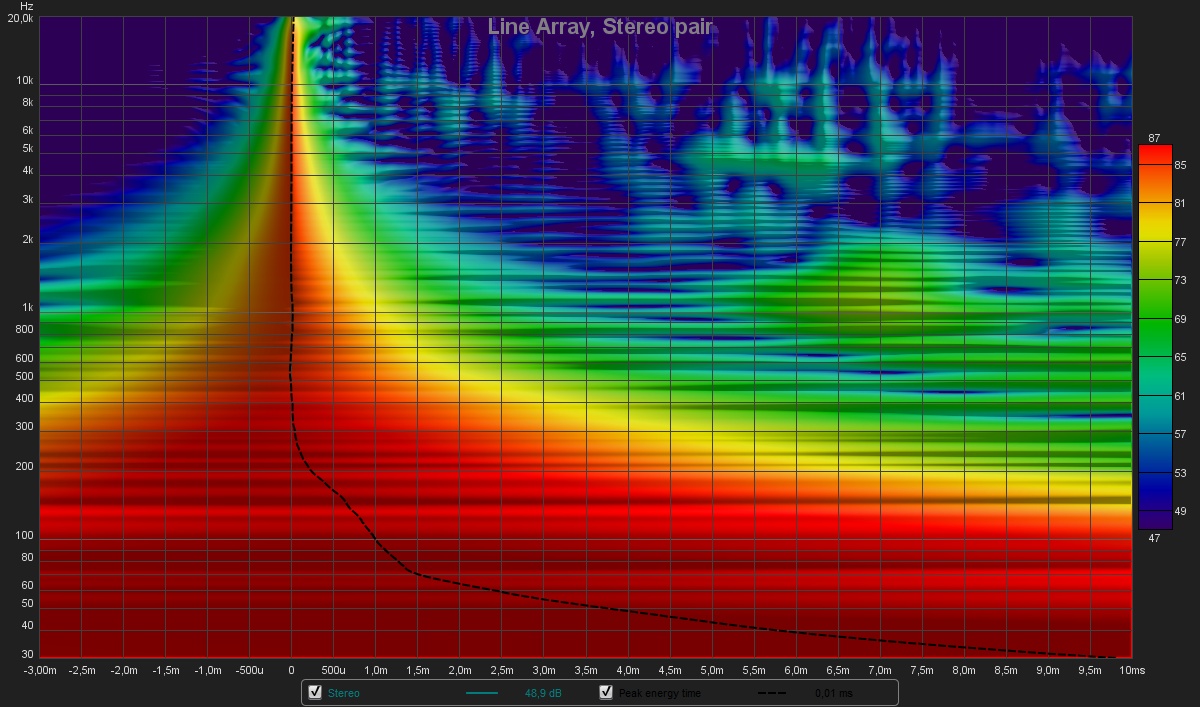
Clearly Horns avoid the walls a bit better, but floor to ceiling arrays do have some other advantages that come in handy in a small room.
Before starting this projects it was between going with horns or arrays. Horns was out due to my spouse not liking the way they looked. So I asked her if I could build speakers that fit in a very small spot on the floor. She said yes to that, after which I told her they would be about 2.25m high 😀.
The DSP I use has been a PC Xeon Workstation with an Asus Sonar Essence ST sound card, optically coupled to a Musical Fidelity M1 DAC.
I use JRiver as the media player and use it's internal convolution engine with 65536 taps (simply because I can) for FIR filters. Above about 500 Hz all corrections done are minimum phase.
My Amplifier is a 350 watt/channel Goldmund Telos 400 clone.
Treatment was done by measuring and hunting down first reflections that showed up in the IR at the LP.
Based on those measurements I have 3 rather large damping panels, 2 of them hidden, one posing as a "poster". The RT numbers from REW determined the thickness of the panels used to get as even a balance as I could.
Here's a stereo measurement at the listening position interpreted by APL_TDA:

Or as seen in REW with similar settings as your SH50 graph:
Clearly Horns avoid the walls a bit better, but floor to ceiling arrays do have some other advantages that come in handy in a small room.
Before starting this projects it was between going with horns or arrays. Horns was out due to my spouse not liking the way they looked. So I asked her if I could build speakers that fit in a very small spot on the floor. She said yes to that, after which I told her they would be about 2.25m high 😀.
Last edited:
Same thing for the K-402-MEH using a BMS 4592ND dual diaphragm driver high passed at 6.2 kHz and first order crossover at 450 Hz using IIR filters only:
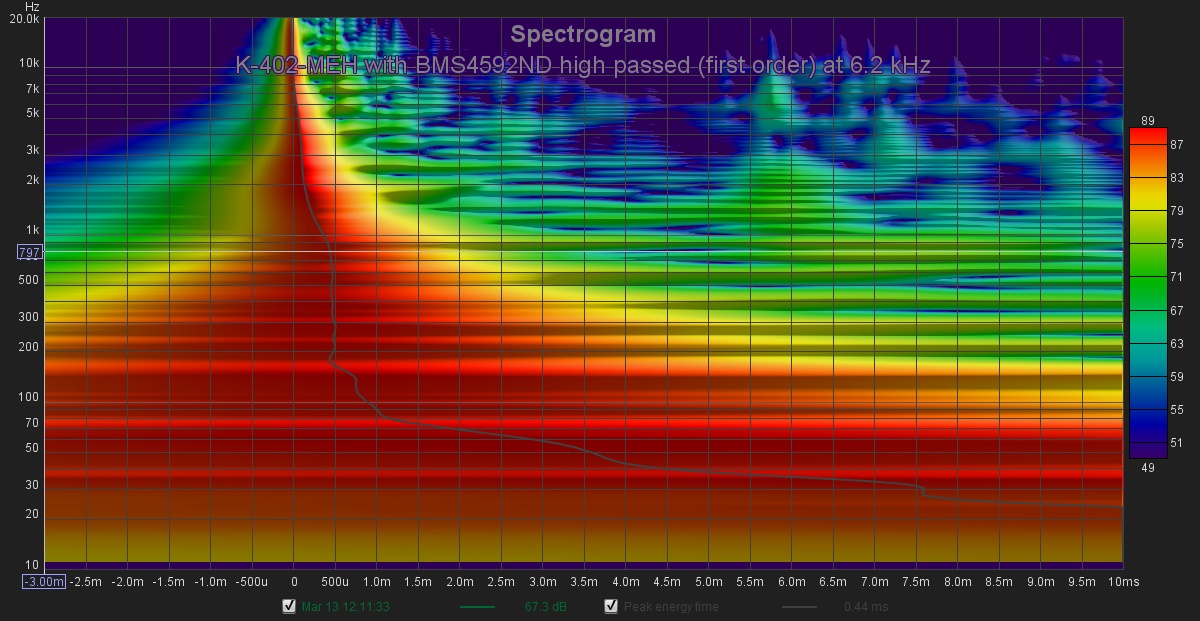
I understand about the small room thing. You've done a magnificent job for your listening room and its size.
Chris
I understand about the small room thing. You've done a magnificent job for your listening room and its size.
Chris
Attachments
That was exactly what I disagreed with and one has to wonder whether it has effected their researchers.JBL / Harman has an access to very well treated room and they should do their own study in those rooms. The meaningful aspect of Dr. Tool's study is he tries to bridge well treated room to the average consumer room, which is far from nonsense, I think.
Thanks Wesayso. Looks like I have something to read to keep me off the streets.
And to think that I thought the K-402-MEH thread was a bit long at 35 pages...😉
Chris
And to think that I thought the K-402-MEH thread was a bit long at 35 pages...😉
Chris
That was exactly what I disagreed with and one has to wonder whether it has effected their researchers.
I see. I have not seen their recent technical papers about their professional monitor designs, but the papers JBL was publishing about pro monitors in 80-90's were based on the objective performance in well controlled studio environment. They stopped doing it? My impression is, JBL (or Dr. Toole) had shifted their main interest to subjective performance in uncontrolled environment after they were defeated in the studio monitor war by Genelec and the others. I think their M2 project was designed by their recent objective performance study. Please correct me if I’m wrong.
Well, what I’m guessing is, JBL has been trying to find the correlation between objective performance in controlled room and subjective performance in real world (uncontrolled room). Since we can access huge amount of studies about objective performance, those rare Dr. Toole’s studies have some hints for who has an interest in this subject. I wish I would read more about subjective performance studies like those. Just interested. I have my own study about BBC dip or such, but it is nothing but my preference in my particular environment. lol. 🙂
Sean Olive from Harman / Samsung / JBL published a really interesting study on listener preferences recently:
Preference Score (beta) - Google Drive
A lot of data to process, but the map of "preference" vs "cost" is really interesting.
Preference Score (beta) - Google Drive
A lot of data to process, but the map of "preference" vs "cost" is really interesting.
Attachments
Thanks for the interesting data. I appreciate they included some DIY speakers (Philarmonic AAM and Zaph ZA5.2). And it's satisfying to see how extremely well they scored.
Speaker Data 2034: 2020 - The speaker data revolutionSean Olive from Harman / Samsung / JBL published a really interesting study on listener preferences recently:
Preference Score (beta) - Google Drive
A lot of data to process, but the map of "preference" vs "cost" is really interesting.
2020-01-26 – MZKM released an open “Master Preference Ratings for Loudspeakers” database based on the patent and formulas by Dr. Sean Olive from 2004. This database was made for the ASR Spinorama measurements.
This looks it's been taken from Audio Science Review's measurements (not listening lists) and correlated with Harman study on preferences.Sean Olive from Harman / Samsung / JBL published a really interesting study on listener preferences recently:
Preference Score (beta) - Google Drive
A lot of data to process, but the map of "preference" vs "cost" is really interesting.
An interesting side note here. At the Munich hifi show two years ago Ocean Audio demoed their Monterey.
Monterey – OceanWay Audio
The Monterey's top section looks very similar to the HR5 which where tested in your link and came out very poorly. At the hifi show, the people who listen to the Ocean Way Monterey seemed to be blown away by how well they played and the ones I talked to said it was the best and most realistic sound they had ever heard. Just food for thought. 😉
It's HR4. Old short 😀 thread about OceanWay HR4?..The Monterey's top section looks very similar to the HR5
Thanks.It's HR4. Old short 😀 thread about OceanWay HR4?..
They still might be quite similar.
I don't think the measurements of HR5 are bad.
Ocean Way HR5 Studio Monitor Review | Audio Science Review (ASR) Forum
Sure, they have some frequency and off-axis deviations and there are clearly rooms for improvements, but the overall horizontal directivity is quite uniform. Unlike most of the other speakers measured at ARS, they don't exhibit the horizontal collapsing polar in a sensitive area but is able to remain the directivity lower. To me, that's more important than some high Q deviations.
The high frequency raise may not be much of problem either, especially with some listening distance. B&W very often has a similar raise in the highs by the way. It can be done without sounding harsh and too bright and give a feeling of more air. But it's not neutral/correct.
- Home
- Loudspeakers
- Multi-Way
- The Preference for Direct Radiators
